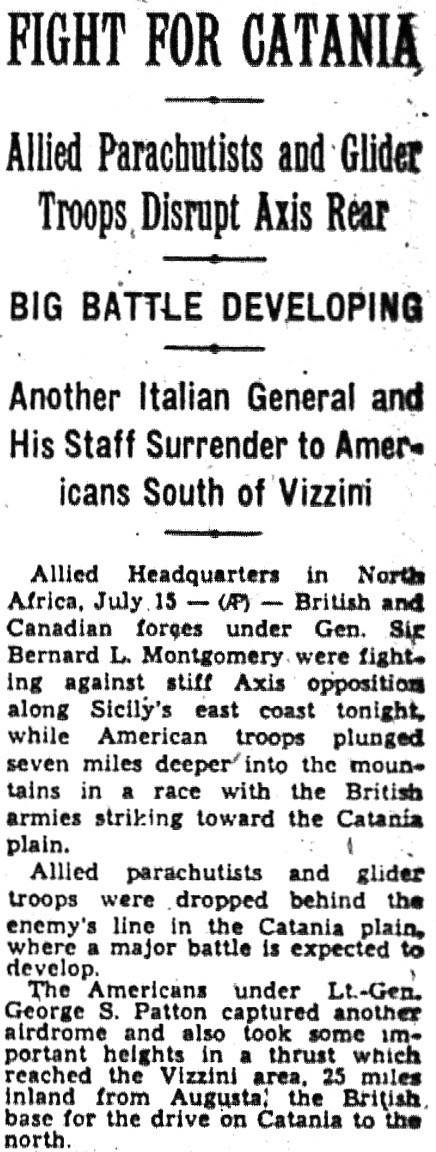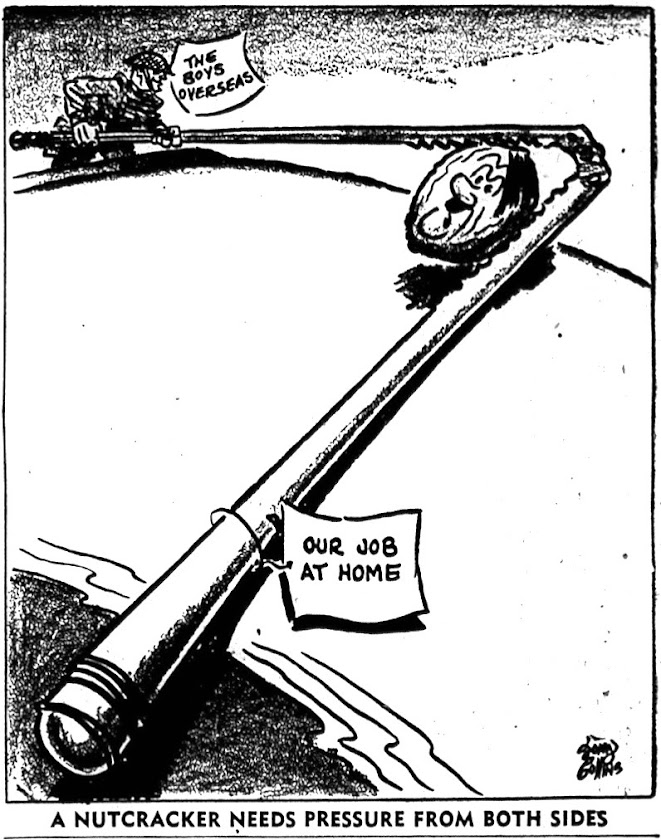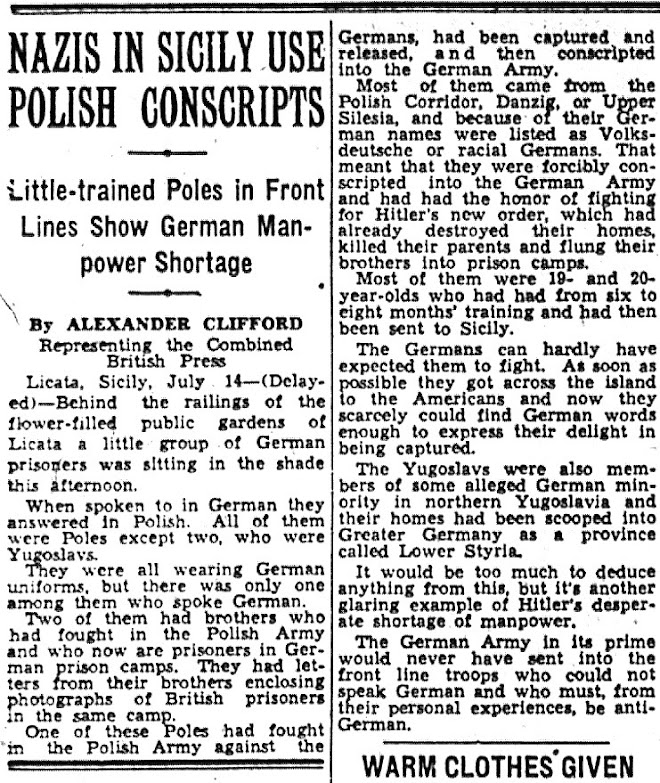The Allied Forces Continue to Drive Northward in Sicily
"Happy Italians Quit in Droves" Says Ross Munro
Civilian resident of Misterbianco, near Catania, paints the slogan ‘Viva
England’ on a wall after the village had been occupied by the Eighth Army
From Photos re The Drive for Messina 10 July - 17 August 1943
© IWM NA 5450
A view of the back of the first photograph. Photo Credit - Drennan (Sgt)
© IWM NA 5450
The action will be hot - but not always heavy - for 3 - 4 more weeks, i.e., during the invasion of Sicily and as British, Canadian and U.S. troops make their way to Messina, their ultimate destination on the north-east corner of the island. German and Italian forces will make many a day and many a mile a tough haul, though we will often read that Italian forces did not have much fight in them.
First, the headline from The (Montreal) Gazette, one of Canada's leading newspapers of the War Years:
"It's all downhill from here?"
Though "the exact position of the Canadians had not been disclosed," I have a pretty fair idea where many members of the 80th and 81st Flotillas of Canadian Landing Crafts (i.e., LCMs or Landing Craft, Mechanised) were working, bringing all the materials of war to shore on the eastern coast of Sicily.
The 80th and 81st Flotillas served at Red, Amber and Green Beaches
in the HOW and GEORGE Sectors, between Gallina in the south and
Fontane Bianche in the north of the above map. Research, Part 1
"Italians surrendering in droves..." seems to be the order of the day:
When Canadians in Combined Operations took part in the invasion of Italy (e.g., at the toe of the boot) beginning in early September, some mention staying in a house "with no roof." Below we find out what likely happened to the roof:
A few of the Canadian sailors serving on the eastern shores, at the bridgeheads "the Luftwaffe (were) concentrating on" (mentioned above), share in memoirs that the Luftwaffe attacked on a regular basis ("every two hours" said more than one) for the first three days, as the building up of supplies was paramount.
My father wrote the following:
We fired at everything. I saw P38s, German and Italian fighters and my first dogfights. Stukas blew up working parties on the beach once when I was only about one hundred feet out. Utter death and carnage. Our American gun crews had nothing but coffee for three or four days and stayed close to their guns all the time. I give them credit.
Ephus P. Murphy’s pet monkey went mad and we put it in a bag of sand meant to douse incendiary bombs and threw him over the side. The Russian Stoker on our ship, named Katanna, said Dieppe was never like this and hid under a winch. Shrapnel and bombs just rained down.
"Dad, Well Done," page 31
Drew Middleton's article concludes:
Another fine contribution is made by one of Canada's leading war correspondents below. And the contribution of Canadian troops was very, very good as well, as this article ends with high praise for their efforts:
Photo Credit - Imperial War Museum
Though 'Monty's Men' are mentioned in the headline, this type of article reminds us there is a number of battle fronts in the midst of hot and heavy action:
Catania is a major port city on the eastern coast of Sicily, and high on the list of Allied war planners for capture and them immediate use. The article that follows focusses on the "BIG BATTLE DEVELOPING":
Screenshot from "Advancing on Catania". A link to video follows.
Please click here to view a video (7min:28sec) entitled "Advancing on Catania" produced and then issued by Grumant-British News in August 1943. A short summary is provided:
A map illustrates the advance to Catania, images of battle aftermath abound, guns are fired in Lentini, Yugoslav men work among the wreckage, soldiers distribute food to hungry Sicilians, Italian prisoners are searched, fighting carries on in the streets of a small village, the Primsola Bridge is captured from German paratroopers before they can blow it up, a corn field burns, medics assist the wounded, and soldiers splash and bathe in a stream.
"Warning. Booby-traps in Houses. Keep Out!!" (8 seconds of action!)
A 'good news' story follows:
Canadians who served in Combined Operations in the 80th and 81st Flotillas (of landing craft) witnessed the the British hospital ship mentioned above (HMHS Talambra) being bombed before it sunk off the eastern coast of Sicily.
As found at Wikipedia - https://en.wikipedia.org/wiki/SS_Talamba
One can see the Talamba listed amongst the ships lining up to be unloaded at HOW Beaches in the map (Appendix A) below:
Foot Wallace... Found in St. Nazaire to Singapore, Volume 1, page 179
Please click here to read an entry on this blog/website entitled Story re Combined Ops, "Revenge for HMHS Talamba"
And please click here to read a story by a survivor of the sinking of the hospital ship.
I have several books and accounts re the Dieppe Raid, a few by men who were there (e.g., by AB Al Kirby, RCNVR/Combined Operations from Woodstock, ONT) and I will soon search AbeBooks* to see if Wallace Reyburn's account is still available:
*AbeBooks has links to 'fine' used copies, starting at $84 US, incl. shipping
(which is a bit cheaper than driving to Alexander Books in Ancaster, ONT)
From the editorial page of The Gazette:
RAF and RCAF were soon working together near GEORGE Beaches (home to the 80th Flotilla of Canadian Landing Crafts for approx. 30 days). Not mentioned below, but my father walked from 'The Savoy' (a cave near GEORGE Beach) to the closest Allied airfield about 2 - 3 km. away, for supper and vino, at least once:
Sailors living at 'The Savoy' would say, "Send mail... and food!"
Yugoslav men were mentioned in the video shared earlier (i.e., "Advancing on Catania") and they are again (below), along with "Polish Conscripts", some of whom were unable to "find words German enough to express their delight in being captured." Confused? Read on:
Did you know that Canadian troops could make things go 'Poof'?
Ross Munro, Canadian war correspondent, makes good stories
and headlines. Photo below is from an earlier post in this series
In this series, the above photograph is getting
a lot more mileage than the jeep!
Please click here to view Research: Three Months in the Mediterranean, 1943 (9)
Unattributed Photos GH



































No comments:
Post a Comment